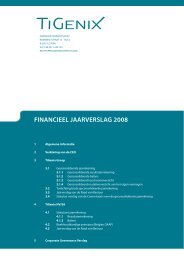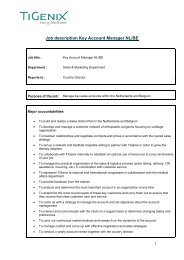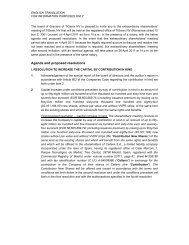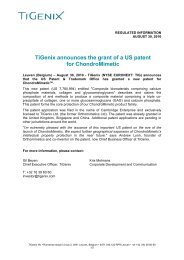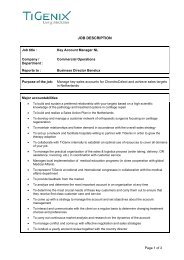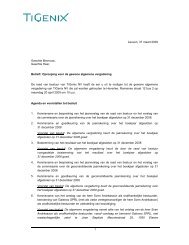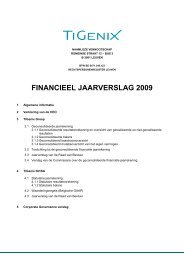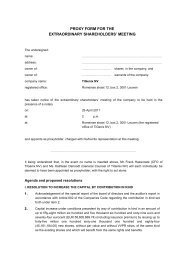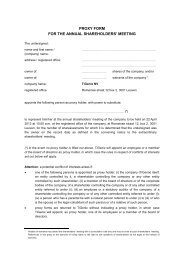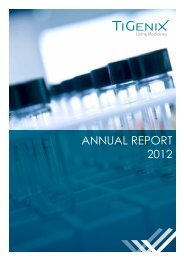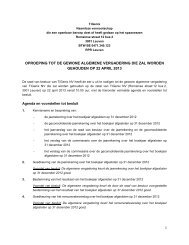ANNUAL FINANCIAL REPORT 2010 2010 - TiGenix
ANNUAL FINANCIAL REPORT 2010 2010 - TiGenix
ANNUAL FINANCIAL REPORT 2010 2010 - TiGenix
- No tags were found...
Create successful ePaper yourself
Turn your PDF publications into a flip-book with our unique Google optimized e-Paper software.
in Cellerix’ GMP facility in Madrid and are delivered to patientsvia different routes of administration to best take advantage ofthe ASC’s immunomodulatory properties.Cellerix’ product candidates are based on innovative celltherapy technologies that exploit the ASC’s effectivemechanism for treating immune-mediated inflammatoryprocesses based on the cell’s anti-inflammatory properties.Cellerix’ lead product candidate, Cx601, completed a Phase IIclinical trial investigating its potential in the treatment ofpatients with complex perianal fistula suffering from Crohn’sdisease in <strong>2010</strong>. In Phase II, Cx601 showed an efficacy rateat twenty four weeks above 56% in the complete closure oftreated tracts and 69.2% of patients had a reduction in thenumber of initially draining tracts. The trial provided excellentsafety data, reinforcing the very safe profile of the product.Complex perianal fistula is a rare, painful and debilitatingcondition often suffered by patients diagnosed with Crohn’sdisease or other inflammatory bowel diseases. The incidencein Europe 27 is estimated to be around 51,000 patients per yearaccording to an internal market study conducted by Cellerixtaking into account numerous publications. Based on therelatively rare occurrence, severe nature and lack of effectivetreatments of the therapeutic indication, Cx601 receivedOrphan Drug status from the EMA in 2009, a designation thatprovides several benefits for product development, includingresearch grants and subsidies, detailed feedback and assistancefrom the EMA in developing clinical trials, a streamlined processfor obtaining the relevant regulatory approvals in Europe as wellas up to 10 years European marketing exclusivity from the dateof the product’s launch.Cellerix’ second clinical product candidate, Cx611, has initiatedenrolment in a Phase I/II clinical trial to assess its safety andefficacy as an intravenous treatment for patients suffering fromrheumatoid arthritis. Cellerix has additional product candidatesin various stages of preclinical development, includingCx621 (treatment of autoimmune diseases via intralymphaticadministration of ASCs), which is scheduled to enter the clinicin 2011, Cx602 (endoscopic treatment of Inflammatory BowelDisease (IBD)) and Cx603 (intra-articular administration of eASCsfor the treatment of osteaoarthritis).Further products that do not build upon the same platform are:• Cx501: A chimeric skin combining autologous keratinocytes,allogeneic fibroblasts and a blood plasma matrix, forthe treatment of a rare hereditary skin disease calledRecessive Dystrophic Epidermolysis Bullosa (“RDEB”),which is characterized by the deficiency of collagen VII.Cx501 received Orphan Drug designation by EMEA in April2006 and completed a 12 patient phase II clinical trial intwo different centers in Spain in <strong>2010</strong>. Even though the trialdemonstrated the safety of the product and its engraftmentat 12 months post implant evaluation, results were notstatistically significant. This made the intended objectiveto register Cx501 for RDEB after Phase II based on theregulation of “approval under exceptional circumstances” 43and use the underlying the development of Cx501 toexpand its application or that of similar products to otherindications an unrealistic goal. These results, together withCellerix’ revised strategy to focus on its eASC platform,resulted in Cellerix’ decision to divest the Cx501 product atthe end of <strong>2010</strong>.• Cx911: Autologous regulatory T-cell platform that is beingdeveloped based on the immunosuppressive characteristicsof these cells and their particular potential in the modulationof self-reactive T-cells in autoimmune diseases. Cellerixis developing a process for the in-vitro generation ofregulatory T-cells based on the use of adipose derived cells,with the intention to develop therapies for the treatment ofautoimmune diseases.In line with the strategy being pursued at <strong>TiGenix</strong>, Cellerix aimsto become a fully integrated biopharmaceutical companywith R&D, manufacturing and sales and marketing capabilitiesto market its products in Europe, benefitting from <strong>TiGenix</strong>’existing commercial infrastructure and future manufacturingplant in The Netherlands. License and distribution partnersare being sought to exploit the commercial potential ofits products in other regions. A first such partner is AxcanPharma Inc., who acquired development and marketing rightsto a first autologous product and an option for Cx601 (limitedto the fistula indication) for the North American market in 2007.Cellerix’ manufacturing facility was the first pharmaceuticallaboratory to be approved in Spain by European healthauthorities for the development of cell therapies according toGood Manufacturing Practices (GMP) guidelines and to receiveapproval for commercial production of advanced therapymedicinal products (ATMPs). The facility provides sufficientcapacity to conduct Cellerix’ R&D activities, clinical trials andinitial phases of commercial rollout.43 This regulation provides a pathway for marketing authorization where theapplicant is unable to provide comprehensive data on efficacy and safetyunder normal conditions of use, which was the case in RDEB as an ultraorphan indication.132 • <strong>TiGenix</strong> • Rights Offering



